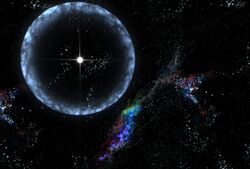Westerhout 31
Topic: Astronomy
 From HandWiki - Reading time: 2 min
From HandWiki - Reading time: 2 min
| Emission nebula | |
|---|---|
| H II region | |
 Artist's impression of SGR 1806-20, a magnetar located in 1806-20 cluster | |
| Observation data: J2000 epoch | |
| Right ascension | 18h 10m 28.6s[1] |
| Declination | −19° 55′ 51″[1] |
| Distance | 11,000–15,000 ly (3,300[2]–4,500[3] pc) |
| Constellation | Sagittarius |
| Notable features | massive H II region Star-forming regions |
| Designations | GRS G010.47 +00.03[1] |
Westerhout 31, also known as W31, is a complex of star formation regions of the Milky Way located in the constellation of Sagittarius.
Characteristics
As happens with other similar star-forming regions, Westerhout 31's location in the Milky Way obscures it so much due to the interstellar dust located between it and the Solar System that it cannot be studied with optical telescopes and for its observation infrared telescopes such as Spitzer, radiotelescopes, or instruments able to detect X-Rays and gamma rays are needed.
Westerhout 31 seems to be actually formed of several star-forming regions at very different distances that from our line of sight appear together: one (formed by the radio-emitting nebulae G10.2-0.3 and G10.6-0.4) at a distance of 3.3[2] or 4.5[3] kiloparsecs from the Sun and other (the radio-emitting nebula G10.3-0.1) much farther away, at a distance between 11.8[4] and 14.5[3] kiloparsecs (in the other side of the galaxy respect to the Sun, with the former distance more likely due to its stellar content).
G10.3-0.1 is the most notable as it contains the star cluster 1806-20 that includes the famous luminous blue variable star LBV 1806-20, the magnetar SGR 1806-20, two blue hypergiant stars, a supergiant O star, three Wolf-Rayet stars, two of them carbon-rich, and other young, massive stars.
The closest complex, formed by G10.2-0.3 and G10.6-0.4, includes a very young (0.6 Myr) star cluster with at least four O stars and five massive YSOs.[2]
See also
References
- ↑ 1.0 1.1 1.2 "W 31". SIMBAD. Centre de données astronomiques de Strasbourg. http://simbad.u-strasbg.fr/simbad/sim-basic?Ident=W+31.
- ↑ 2.0 2.1 2.2 Furness, J. P.; Crowther, P. A.; Morris, P. W.; Barbosa, C. L. et al. (2010). "Mid-infrared diagnostics of metal-rich HII regions from VLT and Spitzer spectroscopy of young massive stars in W31". Monthly Notices of the Royal Astronomical Society 403 (3): 1433–1447. doi:10.1111/j.1365-2966.2010.16206.x. Bibcode: 2010MNRAS.403.1433F.
- ↑ 3.0 3.1 3.2 Corbel, S.; Eikenberry, S. S. (2004). "The connection between W31, SGR 1806-20, and LBV 1806-20: Distance, extinction, and structure". Astronomy & Astrophysics 419: 191–201. doi:10.1051/0004-6361:20034054. Bibcode: 2004A&A...419..191C.
- ↑ Yael Naze; Gregor Rauw; Damien Hutsemékers (2011). "The first X-ray survey of Galactic Luminous Blue Variables". Astronomy 538: A47. doi:10.1051/0004-6361/201118040. Bibcode: 2012A&A...538A..47N.
 |
 KSF
KSF